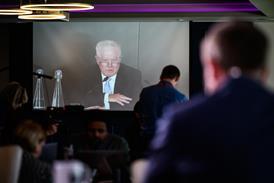[2018] All ER (D) 21 (Feb)
*Re A-F (children) (care orders: restrictions on liberty)
[2018] EWHC 138 (Fam)
Family Division
Sir James Munby P
31 January 2018
Family proceedings – Orders in family proceedings – Deprivation of liberty
Background
The present proceedings related to seven children with ages ranging from 11 to 16. A final care order had been made in respect of each of them in favour of the same local authority. Some of the children were in foster care and others in specialist placements. All were subject to certain restrictions on their movement or liberty. The test cases raised various substantive and procedural questions in relation to the interface between care proceedings brought in the Family Court, pursuant to Pt IV of the Children Act 1989, and the requirements of art 5 of the European Convention on Human Rights (art 5).
Issues and decisions
(1) Whether a child living with a local authority approved foster carer was deprived of his liberty, within the meaning of art 5.
The situation of the young or very young did not involve a confinement for the purposes of component A of Storck v Germany (Application no 61603/00) ([2005] ECHR 61603/00), even though such a child was living in circumstances which plainly satisfied the acid test of confinement in P v Cheshire West and Chester Council and another; P and another v Surrey County Council ([2014] 2 All ER 585).
‘Confinement’ meant an interruption or curtailment of the freedom of action normally to be ascribed to a child of that age and understanding. In most of the myriad instances in life where children were restrained, there could be no question of their being confined so as to fulfil component A of the test in Storck (see [23], [24], [29] of the judgment).
Storck v Germany (Application no 61603/00) [2005] ECHR 61603/00 considered; Surrey County Council v P (Equality and Human Rights Commission intervening) [2014] 2 All ER 585 applied; Re D (a child) (residence order: deprivation of liberty) [2017] All ER (D) 29 (Nov) applied.
(2) At what point in the child’s development, and by reference to what criteria, did one determine whether and when a state of affairs satisfying the acid test which had hitherto not involved a confinement for the purposes of Storck component A and where art 5 had not been engaged, became confinement for that purpose, therefore engaging art 5.
Inevitably, one had to proceed on a case-by-case basis, having regard to the actual circumstances of the child and comparing them with the notional circumstances of the typical child of the same age, station, familial background and relative maturity, who was free from disability. However, a rule of thumb was: (i) a child aged 10, even if under pretty constant supervision, was unlikely to be confined for the purpose of Storck component A; (ii) a child aged 11, if under constant supervision, might be so confined, though the court should be astute to avoid coming too readily to such a conclusion; and (iii) once a child who was under constant supervision had reached the age of 12, the court would more readily come to that conclusion.
In undertaking the comparison required by the acid test, the comparison should not be made with a typical child of the same age who was subject to a care order (see [43], [44] of the judgment).
Surrey County Council v P (Equality and Human Rights Commission intervening) [2014] 2 All ER 585 applied; A London Borough v M and others (through his Children’s Guardian) [2017] Lexis Citation 447 approved.
(3) When would a confinement be lawful.
A confinement would be lawful if, as a matter of substance, it was both necessary and proportionate, namely, the least restrictive regime which was compatible with the child’s welfare and, as a matter of process, had been authorised by a judge in the Family Division in accordance with the procedures identified in the relevant authorities.
An application to the court should be made where the circumstances in which the child was, or would be, living constituted, at least arguably (taking a realistic rather than fanciful view), a deprivation of liberty. There was no need for the court to make an order specifically authorising each element of the circumstances constituting confinement. It was sufficient if the order: (i) authorised the child’s deprivation of liberty at a placement as generally described in some document to which the order was cross-referenced; and (ii) if appropriate, authorised (without the need to be more specific) medication and the use of restraint (see [47]-[49] of the judgment).
(4) What were the key elements of an art 5 compliant process.
The key elements of an art 5 compliant process were, first, if a substantive order (interim of final) was to be made authorising a deprivation of liberty, there had to be an oral hearing in the Family Division (though that could be before a judge under s 9 of the Senior Courts Act 1981 (a s 9 judge)). A substantive order could not be made on paper, but directions could, in an appropriate case, be given on paper without an oral hearing.
Second, the child had to be a party to the proceedings and have a guardian (if at all possible, the children’s guardian who was acting, or who had acted, for the child in the care proceedings) who would, no doubt, wish to see the child in placement, unless there was a very good child-welfare reason to the contrary or that had already taken place. The child, if of an age to express wishes and feelings, should be permitted to do so to the judge in person, if that was what the child wanted.
Third, a bulk application was not lawful, though in appropriate circumstances where there was significant evidential overlap, there was no reason why a number of separate cases should not be heard together or in sequence on the same day before one judge (see [50] of the judgment).
(5) What were the requirements of the evidence in support of the substantive application (interim or final).
The evidence in support of the substantive application (interim or final) should address and include, first, the nature of the regime in which it was proposed to place the child, identifying and describing, in particular, those features which it was said did or might involve confinement. Identification of the salient features would suffice; minute detail was not required.
Second, the child’s circumstances, identifying and describing, in particular, those aspects of the child’s situation which it was said required that the child be placed as proposed and be subjected to the proposed regime and, where possible, the future prognosis.
Third, why it was said that the proposed placement and regime were necessary and proportionate in meeting the child’s welfare needs and that no less restrictive regime would do.
Fourth, the views of the child, the child’s parents and the independent reviewing officer, the most recent care plan, the minutes of the most recent looked after child or other statutory review and any recent reports in relation to the child’s physical and/or mental health (typically the most recent documents would suffice).
Whether and to what extent new evidence would need to be obtained, or whether reliance on existing evidence would suffice, had to depend upon: (i) the extent to which the existing evidence covered the those various matters; (ii) the age of the existing evidence; and (iii) the extent to which there had been any significant changes since the existing evidence had been prepared. The evidence from the guardian, would typically focus on the confinement and deprivation of liberty issues; unless there had been a very significant change in the child’s circumstances, the application under the inherent jurisdiction should not be an occasion for re-opening the wider welfare issues previously determined in the care proceedings.
Whilst evidence on a child’s competency to consent to a confinement from a social worker who felt properly qualified to express an opinion would not be excluded, it was plainly undesirable that the only evidence on the point should come from an employee of the local authority responsible for the confinement. In any event, it was expected that, if a child whose circumstances required a regime more restricted than that of a comparator contemporary was nonetheless said to have the capacity to give a valid consent, that proposition would normally be made good by evidence from either a child and adolescent psychologist or, depending upon the nature of the child’s difficulties, a child and adolescent psychiatrist (see [51]-[53] of the judgment).
(6) What was the interface with care proceedings.
First, if, when care proceedings were issued, there was a real likelihood that authorisation for a deprivation of liberty might be required, the proceedings should be issued in the usual way in the Family Court (not the High Court), but be allocated, if at all possible, to a circuit judge who was also a s 9 judge.
Second, where care proceedings had been allocated for case management and/or final hearing to a judge who was not a s 9 judge, but it had become apparent that there was a real likelihood that authorisation for a deprivation of liberty might be required, steps should be taken, if at all possible, and without delaying the hearing of the care proceedings, to reallocate the care proceedings, or at least the final hearing of the care proceedings, to a circuit judge who was also a s 9 judge.
Third, the care proceedings would remain in the Family Court and could not be transferred to the High Court. The s 9 judge conducting the two sets of proceedings – the care proceedings in the Family Court and the inherent jurisdiction proceedings in the High Court – could do so sitting simultaneously in both courts.
Fourth, if that was not possible, steps should be taken to arrange a separate hearing in front of a s 9 judge as soon as possible (if at all possible within days at most) after the final hearing of the care proceedings. Typically, there would be no need for the judge to revisit matters already determined by the care judge, unless there were grounds for thinking that circumstances had changed.
Fifth, the evidence should include, in addition to all the other evidence required in the care proceedings, evidence on the matters referred to with respect to the substantive application. Those matters should also be included in the care plan put before the court in the care proceedings.
Sixth, where the care proceedings had been concluded for some time, the process would be that indicated with respect to the substantive application.
(7) What were the requirements for review.
Continuing review was crucial to the continued lawfulness of any confinement. What was required was, first, regular reviews by the local authority as part of its normal processes in respect of any child in care.
Second, a review by a judge at least once every 12 months. The matter had to be brought back before the judge without waiting for the next 12-monthly review if there had been any significant change (whether deterioration or improvement) in the child’s condition or if it was proposed to move the child to a different placement.
Third, the child had to be a party to the review and have a guardian (if at all possible the guardian who had previously acted for the child).
Fourth, if there had been no significant change of circumstances since the previous hearing/review, the review could take place on the papers, though the judge could direct an oral hearing. The form of the next review was a matter on which the judge could give appropriate directions at the conclusion of the previous hearing.
Further, generally speaking, it was preferable for the proceedings to be concluded at the end of the final hearing and, thereafter, at the end of each review, rather than being kept open (see [55], [56] of the judgment).
Shaun Spencer for the local authority.
Frances Heaton QC and Kate Burnell for the children’s guardians.
Karina Weller - Solicitor (NSW) (non-practising).
The present test cases raised various substantive and procedural questions in relation to the interface between care proceedings brought in the Family Court, pursuant to Pt IV of the Children Act 1989, and the requirements of art 5 of the European Convention on Human Rights. The Family Division held that the situation of the young or very young did not involve a confinement, gave a rule of thumb on at what point in the child’s development a child became confined, and gave guidance on matters of process and procedure.






























No comments yet